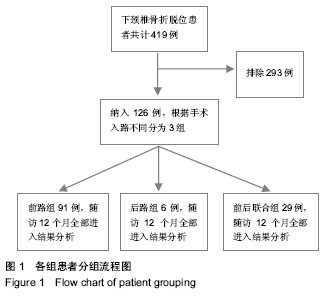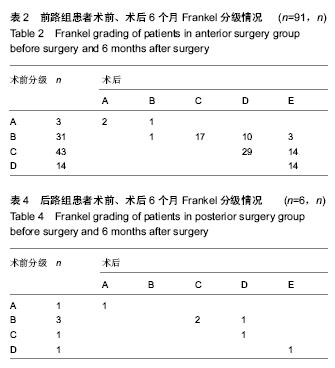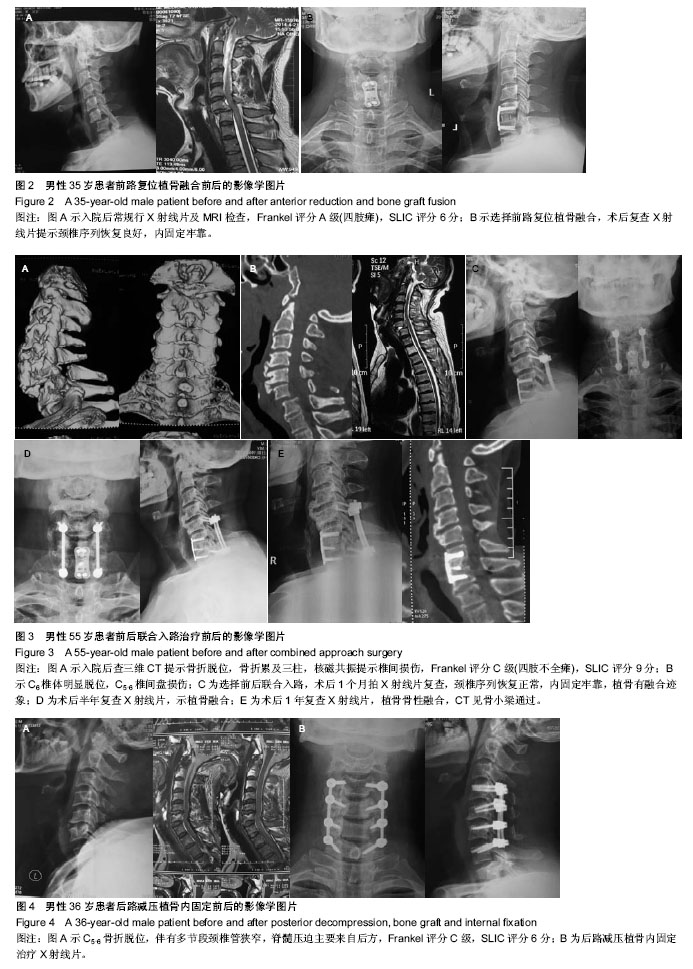| [1] Gomes S, Rudkin S, Tsai F, et al. Bilateral cervical spinefacet fracture-dislocation. West J Emerg Med. 2009;10(1):19.
[2] Ebraheim NA,Patil V,Liu J,et al. Mor-phometric analyses of the cervicals Uperior facets and implications forfacet dislocation. Int Orthop. 2008;32(1):97-101.
[3] Mirza SK,Krengel WF,Chapman JR, et al.Early versus delayed surgery foracute cervical spinalCord injury. Clin Orthop Relat Res. 1999;(359):104-114.
[4] 王岩松,姚猛,刘庆鹏,等.颈椎颈髓损伤后外科治疗时间对预后的影响[J].中国脊柱脊髓杂志,2004,14 (11):659-662.
[5] Eismont FJ, Arena MJ, Green BA. Extrusion of an interver-tebral disc associated with traumatic subluxation or disloca-tion of cervical facets. J Bone Joint Surg Am. 1991; 73(10):1555-1560.
[6] 何仿,田纪伟,林昊,等.下颈椎骨折脱位手术方式的初步探讨[J]. 中国矫形外科杂志,2009,17(20):1524-1526.
[7] Allen BL Jr, Ferguson RL, Lehmann T. Amechanistic classification of closed,indirect fractures and dislocations of the lower cervical spine. Spine. 1982;7:1-27.
[8] Samandouras G,Shafafy M,Hamlyn PJ.A new anterior cervical instrumentation system combining an intradiscal cage with an integrated plate: an early technical report. Spine. 2001; 26(10):1188-1192.
[9] Park HK, Jho HD. The management of vertebral artery injury in anterior cervical spine operation: a systematic review of published cases. Eur Spine. 2012;21(12):2475-2485.
[10] 赵筑川,曹永飞,彭智,等.颈椎前路钛网钢板内固定及自体髂骨植骨在不同颈椎节段中的生物力学研究[J].中国修复重建外科杂志,2006,20(11):1076-1079.
[11] Eismont FJ,Arena MJ.Green BA.Extrusion of an intervertebral disc associated with traumatic subluxation or dislocation of cervical facets.J Bone Joint Surg Am. 1991;73(10): 1555-1560.
[12] Payer M. Surgical management of cervical fractur esinanky losing spon-dy litisusing a combined posterior -anterior approach. J Clin Neurosc. 2006;1:73-77.
[13] Kwon BK, Beiner J, Grauer JN, et al. Anterior / posterior operativer educ -tion of cervical spined islocation : techniques and literatur ereview. Curr Opin Orthop. 2003;14:193-199.
[14] ElMasry MA, Badawy WS , Chan D. Combined anterior and posterior stabilisation fortreating an unstable cervical spine fra cture in apatient with long standing anky losing spondylitis. Injury. 2004 ;10:1064-1067.
[15] 王新伟,袁文,陈德玉,等.复杂性下颈椎损伤的手术方案选择[J].中国骨与关节损伤杂志, 2005, 20(9):577-579.
[16] 赵浩宁,陈军,王自立,等.前后联合入路手术治疗下颈椎骨折脱位[J].中华创伤骨科杂志, 2007, 9(3): 290.
[17] Song KJ, Lee KB. Posterior reduction / fusion foll owed by anteriord ecom-pression / fusion of unreduced bilateral facet fracture-dislocation in the lower cervical trauma . Neurosurg Quart. 2008; 2:109-114.
[18] Mirza SK,Krengel WF,Chapman JR,et al.Early versus delayed surgery for acute cervical spinal cord injury. Clin Orthop. 1999; 359:104.
[19] Black P.Cerebrospinal fluid leaks following surgery.Use of fat grafts for prevention and repair.Technical note .J Nurasurg. 2002;96:250-252.
[20] Johnson MG,Fisher CG,Boyd M ,et al.The rad iograph ic failure of single segm ent anterior cervical plate fixation in trauma tic cervical flexion distraction in juries.Spine. 2004; 29(1):2815-2820.
[21] Lifeso RM,Colucci MA.Anterior fusion for rotationally unstable cervical spine fracture. Spine. 2000;25(2):2028-2034.
[22] Holdsworth F. Fractures, dislocations, and fracture- dislocations of the spine.J Bone Joint Surg Am. 1970;52: 1534-1551.
[23] Denis F. The three column spine and its signification in the classification of thoracolumbar injuries. 1983;8(8) :817-831.
[24] Harris JH, Edeiken-Monroe B, Kopansiky DR. A practical classification of acute cervical spine injuries. Orthop Clin North Am. 1986;1:15-30.
[25] 戴力扬,李海.下颈椎损伤的诊断与治疗[J].中华外科杂志,2007, 45(6):396-400.
[26] 于圣会,盛伟斌,陈浩贤,等. SLIC评分系统在下颈椎损伤治疗中的应用[J].中华创伤骨科杂志,2010,12(5):425-428.
[27] 于圣会,池雷霆,任永安,等.下颈椎损伤分型评分系统的可信度及可重复性研究[J].中华创伤骨科杂志,2012, 14(3): 193-197.
[28] 易龙,孙天胜,张志成,等. SLIC评分系统在无骨折脱位型颈脊髓损伤治疗中的应用[J]中国矫形外科杂志,2014,22(4):304-307
[29] Felsberg GJ, Tien RD, Osumi AK, et al. Utility of MR imaging in pediatric spinal cord injury. Pediatr Radiol. 1995;25(2): 131-135.
[30] Grabb PA, Pang D. Magnetic resonance imaging in the evaluation of spinal cord injury without radiographic abnormality in children.Neurosurgery. 1994;35(3):406-414.
[31] Bracken MB, Shepard MJ, Holford TR, et al. Administration of methylpredniso lone for 24 or 48 hours or tirilaza dmesy late for 48 hours in the treatment of acute spinal cord injury . JAMA. 1997;277(20):1597-1604.
[32] 钟招明,江建明,王吉兴,等.成人无骨折脱位型颈脊髓损伤的手术治疗[J].创伤外科杂志,2012,14(1):19-23.
[33] 孙天胜,张志成,任永安,等.下颈椎损伤分型评分系统的评估及临床应用[J].中华创伤杂志,2009,25(5):403-407.
[34] Ito S, Ivancic PC, Pearson AM, et al. Cervical intervertebral disc injury during simulated frontal impact.Eur Spine J. 2005;14(4):356-365. |



